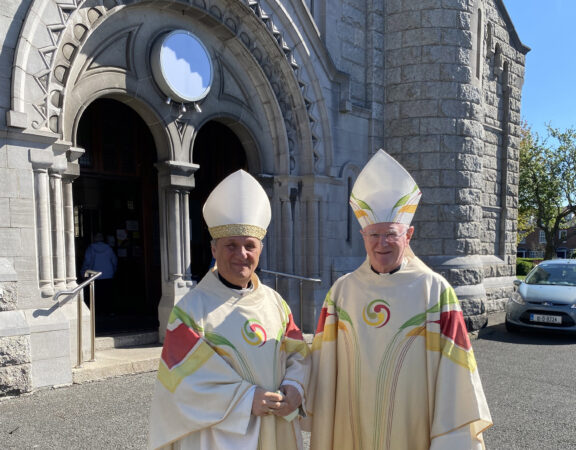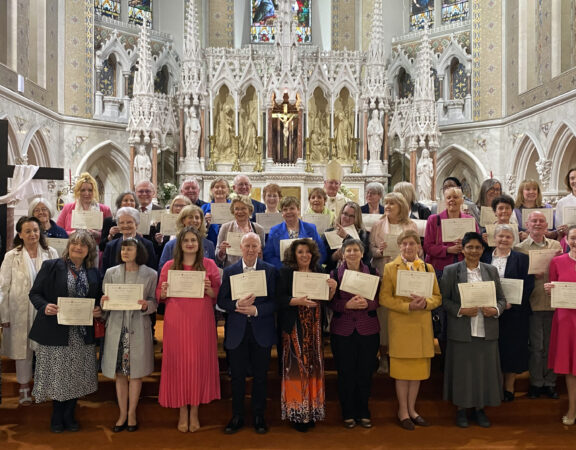OPENING OF THE 2005 DUBLIN DIOCESAN PILGRIMAGE TO LOURDES
Homily Notes of
Most Rev. Diarmuid Martin
Archbishop of Dublin, Primate of Ireland
—————-
8th September 2005
Most Rev. Diarmuid Martin
Archbishop of Dublin, Primate of Ireland
—————-
8th September 2005
I welcome all who have joined us on the 2005 Dublin Diocesan Pilgrimage to Lourdes. We have come from all corners of the diocese. After all the excitement and the fatigue of these past days of preparation we now find ourselves gathered beneath the Grotto where Our Lady appeared to Bernadette, a poor young peasant from a poor town in the South West corner of France.
We gather beneath the Grotto, we gather in this extraordinary atmosphere of silence and yet of movement, of efficient organization and yet of contemplation. We gather as young persons and old, as persons who are sick or in good health; we gather as priests, as religious and as lay persons. Some are here for the first time; some have chalked up many years as pilgrims, as helpers, as invalids.
Why are we here? Why should over 2500 people from all over the Archdiocese of Dublin come here, and be here with thousands of other pilgrims from all over the world, so different and yet so similar to ourselves, who come to this shrine.
What is it about this Shrine? How can it bring together so many and impress so many: the strong believers, the plain curious, and even perhaps the cynical. Yet coming here to Lourdes all go away with a unique experience.
Why should over 200 young people come here from the Dublin diocese to Lourdes as volunteers when they could just as well have gone to the fashionable resorts of France and Spain not very far from here? What is it that is so special about Lourdes?
It is something that is hard to explain. Just as the story of Lourdes has been hard to explain over the period since Bernadette first came to this isolated spot and encountered the Blessed Virgin. The fact that Mary should have appeared here to a poor shepherd girl is in itself something remarkable. The fact that that encounter should result in something which has had an impact for generations, something that has affected the lives of so many and over such a long period is a question that is hard to explain.
Lourdes is one of the most visited Shrines in the world, of any faith. Lourdes has flourished over decades in the face of a culture of various generations of hostility and miscomprehension. The apparitions at Lourdes occurred at a high point in a culture of rationalism, where everything had to have its rational explanation or else it was unreal or unauthentic.
Lourdes has quietly continued in similar dominant cultures, whether of atheistic Marxism or agnostic materialism. Yet Lourdes still retains its unique character and appeal. Lourdes is a place where accepted values are overturned. Lourdes is a place where human weakness is looked on with respect. The sick and the handicapped are treated in Lourdes as our most treasured pilgrims. No one in Lourdes is judged on outward appearances. A holy shrine welcomes humble sinners. In a world full of self confidence, those who are troubled, who are anxious are accepted and recognised really as pilgrims, on the path towards an acceptance of that “joyful hope” to which we are all called.
Lourdes is a shrine of Mary, but Mary is the first to point our hearts and minds towards her son Jesus. Mary in her short conversations with Bernadette indicates to us the path towards her son: the path of repentance and penance, the path of prayer and of the Eucharist.
Lourdes is a place of prayer. Who knows how many persons, young and old, have silently come to some quiet corner of this sanctuary to place themselves in prayer before Jesus, a prayer of humility admitting one’s weakness, a prayer of petition seeking something important for our own lives or for the lives of those dear to us, a rare moment of genuine prayer of worship an adoration, a recognition of the lordship and transcendence of God.
Lourdes rejects dominant cultures and turns them head over heels. It is not the strength of our own forces which triumphs here, but the power of God. Prayer is a unique way of refinding a balance in our values in today’s world. In a world dominated by market values, and personal attainment, prayer means placing oneself humbly in the presence of a reality that is greater than us and recognising that our lives are in the hand of someone greater than us who cares and supports us.
Prayer is that moment in which we rediscover the values of life are not the obvious one of the media or society, but in knowing that there is something more vital and deeper in life. Prayer is not holy conformity but real revolution in the face of the accepted wisdom that on our own we can do everything. The young person who learns to pray becomes independent of the pressures of our culture. The sick person who learns to pray becomes one who refinds their meaning and hope beyond their outward condition.
Prayer is a witness to the total otherness of God. When we pray we attempt to enter into the realisation of that reality. Prayer is the moment in which our faith is expressed in its deepest and most concrete form. It is the moment in which we recognise that the God who is other is a real dimension of our reality, of the reality of my life. Prayer is the moment in which we attempt to make our lives into a concrete response of love to the superabundant love which God shows for us.
On the feast of the Maternity of Jesus we see how both Mary and Joseph discovered their own authenticity and mission in following the will of God, even at the price of radically changing their own plans.
She is a model for all humanity, also because in being free from original sin, she in a very special way mirrors that original image of God which was the distinctive mark of humankind, before the damaging and disfiguring sin of Adam. Through her obedience to the Word of God, Mary constitutes the beginnings of the restoration of the original harmony which God had desired for his creation, that redemption through Jesus which will free humanity and creation from the effects of original sin.
Mary, in her entire life, mirrored that fidelity of God and remained faithful and attentive to his word in every moment of her life. We see that from the very first mention of her in the Gospel, as we heard this evening, to the last mention in the Acts of the Apostles, we find her gathered with the small community of the early Church, in prayer and in expectation of the Spirit, imploring the gift of the Spirit for the Church. Mary is always presented as being the one who listens to the word of God and puts it into practice, even in the most difficult moments, because she knew that God would always be faithful to his Word.
Mary is the true model of the Church. Church is, after all, the place where, after the example of Mary, believers gather in prayer and in joyful hope and expectation, knowing that if we open our hearts to his Word, God’s powerful presence will work through and in us and will come to change us, our hearts and lives and to save us and all creation.









